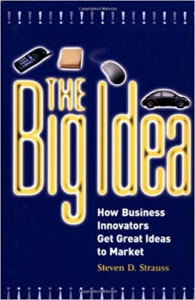By Steve Strauss
(From the editor: This article was originally published on TheSelfEmloyed.com, founded by CEO Steve Strauss.)

What would you do if it was your job to tediously copy by hand, for hours on end, day after day, intricate, confusing, detailed patent applications?
Get a new job, right?
That might be true for most of us, but it wasn’t true for Chester Carlson. Instead of looking for a better gig, Carlson invented a better way, namely, the process that led to the Xerox copier.
I first wrote about Carlson and his amazing journey and invention in my book, The Big Idea. Frustrated by his day job, Carlson went home every night to his place in the Astoria apartment building in [Queens] to study photography, the physics of light, paper, and printing. It took three long years, but in his makeshift Astoria lab Carlson finally perfected what he called “electronphotography” and on October 22, 1938, he successfully created a blurry yet legible copy that read, “10-22-38 Astoria.”
“10-22-38 Astoria” now sits in the Smithsonian.
What Carlson created that day was a lot more than a new way to save some time. In the end, the Xerox machine begat nothing less than a workplace revolution that continues to this day. As I am often wont to say, this is the greatest time ever to run a small business, and the main reason is technology. These days, companies like Xerox are creating a plethora of tools that enable small business to look as big as their biggest competitors. Indeed, it looks to me like Xerox has done it again, with their largest launch of new products ever occurring on March 29.
But before I get to that, what I want to share first is an observation that I hope resonates with my small business brothers and sisters, namely that when Chester Carlson had his big idea, he essentially was a gig worker, not unlike you maybe.
- He had a job he hated.
- He had an idea he loved.
- He had the will and the passion to work on his side gig at night, on weekends, etc.
Even so, it took almost a decade before his nascent technology became a viable product, and that was only after having been turned down by IBM and a host of other big companies. But Chester Carlson had two things going for him that allowed him to persevere, things you should keep in mind if you too are looking to innovate in your business.
 First, he had a great idea/product. This is where innovation starts. One thing I learned by studying and interviewing some of the great inventors and innovators of the 20th century was that the sweet spot of innovation occurs when a great idea meets a market need. Find that, and you will hit a homerun.
First, he had a great idea/product. This is where innovation starts. One thing I learned by studying and interviewing some of the great inventors and innovators of the 20th century was that the sweet spot of innovation occurs when a great idea meets a market need. Find that, and you will hit a homerun.
Xerox’s latest ConnectKey® products (all 29 of them!) are a perfect example. As the folks from Xerox told me, “It’s time to stop thinking about printers as standalone, task-specific workhorses, and start demanding more up-to-date, useful—and useable—solutions.”
In order to do that, they re-thought the printer and its place at the office. What you will be finding in your office in the near future are beyond multifunction devices; they are smart workplace assistants that will be the hub of your connected office, delivering an intuitive user experience, providing mobile and cloud connectivity, and critically, complete security. The interface will look much like your phone or tablet, interactive and with downloadable apps of your choice intended to allow you to do a variety of tasks. As Xerox told me, you will be able to “swipe and tap your way through simplified workflows on a large, colorful, tablet-like screen.”
How cool is that?
The second thing Chester Carlson understood was that he couldn’t do it alone, he needed partners. In his case, he eventually teamed up with a man named Joe Wilson who ran a photography business called Haloid. Combining Wilson’s business sense with Carlson’s inventive genius is what it took to build Xerox (a name, by the way, created when Wilson hired a linguistics professor to help name the technology. They combined two Greek words, Xeros – “dry” – and Graphos – “writing” – to create Xerography, literally, “dry writing.”)
The spirit of partnership is alive and well at Xerox today. With the launch of the latest ConnectKey products, Xerox channel partners – the businesses that you work directly with and purchase equipment from for your small business, can innovate themselves. They can use the Xerox App Gallery to build custom applications to meet the specific needs of small business owners. With partnerships like this, it’s not hard to imagine a future where you can talk to your device to have it complete tasks, for example.
Innovation is one of those things business people love to talk about and strive for. If you ever watch the show Shark Tank, you will see it in display in spades. The lesson of Xerox’s almost 100 years of innovation shows us that great innovators are visionaries, problem solvers, and teammates.
And that is the kind of success recipe that any small business should really strive to copy.
Here’s a great quick video on how Xerox’s ConnectKey® technology can help you be more productive:
ARVE Error: Mode: lazyload not available (ARVE Pro not active?), switching to normal mode



